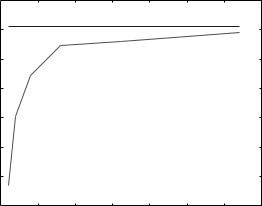
Fundamentals Of Wireless Communication
.pdf
258 |
Multiuser capacity and opportunistic communication |
sources of hindrance to implementing multiuser diversity in a real system. We will see a simple and practical scheme using an antenna array at the base-station that creates fast and large channel fluctuations even when the channel is originally slow fading with a small range of fluctuation.
6.7.1 Fair scheduling and multiuser diversity
As a case study, we describe a simple scheduling algorithm, called the proportional fair scheduler, designed to meet the challenges of delay and fairness constraints while harnessing multiuser diversity. This is the baseline scheduler for the downlink of IS-856, the third-generation data standard, introduced in Chapter 5. Recall that the downlink of IS-856 is TDMA-based, with users scheduled on time slots of length 1.67 ms based on the requested rates from the users (Figure 5.25). We have already discussed the rate adaptation mechanism in Chapter 5; here we will study the scheduling aspect.
Proportional fair scheduling: hitting the peaks
The scheduler decides which user to transmit information to at each time slot, based on the requested rates the base-station has previously received from the mobiles. The simplest scheduler transmits data to each user in a round-robin fashion, regardless of the channel conditions of the users. The scheduling algorithm used in IS-856 schedules in a channel-dependent manner to exploit multiuser diversity. It works as follows. It keeps track of the average throughput Tk m of each user in an exponentially weighted window of length tc. In time slot m, the base-station receives the “requested rates” Rk m , k = 1 K, from all the users and the scheduling algorithm simply transmits to the user k with the largest
Rk m
Tk m
among all active users in the system. The average throughputs Tk m are updated using an exponentially weighted low-pass filter:
T |
m |
+ |
1 |
= |
1 |
− |
1/tc Tk m + 1/tc Rk m |
k = k |
(6.56) |
||||
k |
|
|
1 |
− |
1/t |
c |
T |
m |
k |
k |
|
||
|
|
|
|
|
|
|
k |
|
|
= |
|
||
One can get an intuitive feel of how this algorithm works by inspecting Figures 6.14 and 6.15. We plot the sample paths of the requested data rates of two users as a function of time slots (each time slot is 1.67 ms in IS-856). In Figure 6.14, the two users have identical fading statistics. If the scheduling time-scale tc is much larger than the coherence time of the channels, then by symmetry the throughput of each user Tk m converges to the same quantity. The scheduling algorithm reduces to always picking the user with the highest
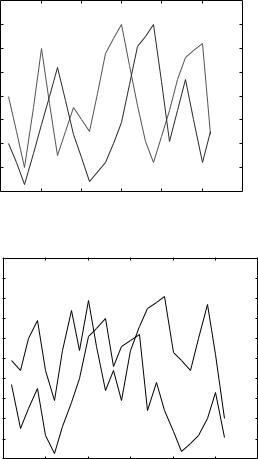
260 |
Multiuser capacity and opportunistic communication |
In short, data are transmitted to a user when its channel is near its own peaks. Multiuser diversity benefit can still be extracted because channels of different users fluctuate independently so that if there is a sufficient number of users in the system, most likely there will be a user near its peak at any one time.
The parameter tc is tied to the latency time-scale of the application. Peaks are defined with respect to this time-scale. If the latency time-scale is large, then the throughput is averaged over a longer time-scale and the scheduler can afford to wait longer before scheduling a user when its channel hits a really high peak.
The main theoretical property of this algorithm is the following: With a very large tc (approaching ), the algorithm maximizes
K
log Tk |
(6.57) |
k=1
among all schedulers (see Exercise 6.28). Here, Tk is the long-term average throughput of user k.
Multiuser diversity and superposition coding
Proportional fair scheduling is an approach to deal with fairness among asymmetric users within the orthogonal multiple access constraint (TDMA in the case of IS-856). But we understand from Section 6.2.2 that for the AWGN channel, superposition coding in conjunction with SIC can yield significantly better performance than orthogonal multiple access in such asymmetric environments. One would expect similar gains in fading channels, and it is therefore natural to combine the benefits of superposition coding with multiuser diversity scheduling.
One approach is to divide the users in a cell into, say, two classes depending on whether they are near the base-station or near the cell edge, so that users in each class have statistically comparable channel strengths. Users whose current channel is instantaneously strongest in their own class are scheduled for simultaneous transmission via superposition coding (Figure 6.16). The user near the base-station can decode its own signal after stripping off the signal destined for the far-away user. By transmitting to the strongest user in each class, multiuser diversity benefits are captured. On the other hand, the nearby user has a very strong channel and the full degrees of freedom available (as opposed to only a fraction under orthogonal multiple access), and thus only needs to be allocated a small fraction of the power to enjoy very good rates. Allocating a small fraction of power to the nearby user has a salutary effect: the presence of this user will minimally affect the performance of the cell edge user. Hence, fairness can be maintained by a suitable allocation of power. The efficiency of this approach over proportional fair TDMA scheduling is quantified in Exercise 6.20. Exercise 6.19 shows that this strategy is in fact optimal in achieving any point on the boundary of
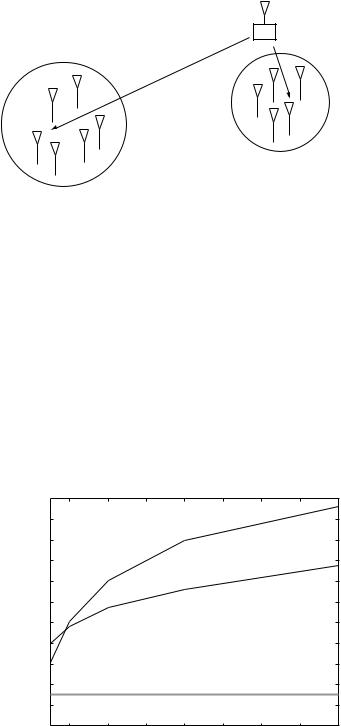
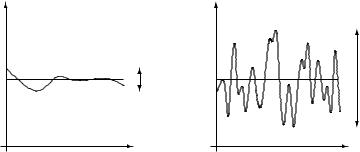
263 6.7 Multiuser diversity: system aspects
In the downlink, the pilot is shared between many users and is strong; so, the measurement error is quite small and the prediction error is mainly due to the feedback delay. In IS-856, this delay is about two time slots, i.e., 3 33 ms. At a vehicular speed of 30 km/h and carrier frequency of 1 9 GHz, the coherence time is approximately 2 5 ms; the channel coherence time is comparable to the delay and this makes prediction difficult.
One remedy to reduce the feedback delay is to shrink the size of the scheduling time slot. However, this increases the requested rate feedback frequency in the uplink and thus increases the system overhead. There are ways to reduce this feedback though. In the current system, every user feeds back the requested rates, but in fact only users whose channels are near their peaks have any chance of getting scheduled. Thus, an alternative is for each user to feed back the requested rate only when its current requested rate to average throughput ratio, Rk m /Tk m , exceeds a threshold . This threshold, , can be chosen to trade off the average aggregate amount of feedback the users send with the probability that none of the users sends any feedback in a given time slot (thus wasting the slot) (Exercise 6.22).
In IS-856, multiuser diversity scheduling is implemented in the downlink, but the same concept can be applied to the uplink. However, the issues of prediction error and feedback are different. In the uplink, the base-station would be measuring the channels of the users, and so a separate pilot would be needed for each user. The downlink has a single pilot and this amortization among the users is used to have a strong pilot. However, in the uplink, the fraction of power devoted to the pilot is typically small. Thus, it is expected that the measurement error will play a larger role in the uplink. Moreover, the pilot will have to be sent continuously even if the user is not currently scheduled, thus causing some interference to other users. On the other hand, the base-station only needs to broadcast which user is scheduled at that time slot, so the amount of feedback is much smaller than in the downlink (unless the selective feedback scheme is implemented).
The above discussion pertains to an FDD system. You are asked to discuss the analogous issues for a TDD system in Exercise 6.23.
6.7.3 Opportunistic beamforming using dumb antennas
The amount of multiuser diversity depends on the rate and dynamic range of channel fluctuations. In environments where the channel fluctuations are small, a natural idea comes to mind: why not amplify the multiuser diversity gain by inducing faster and larger fluctuations? Focusing on the downlink, we describe a technique that does this using multiple transmit antennas at the base-station as illustrated in Figure 6.19.
Consider a system with nt transmit antennas at the base-station. Let hlk m be the complex channel gain from antenna l to user k in time m. In time m, the same symbol x m is transmitted from all of the antennas except that it is
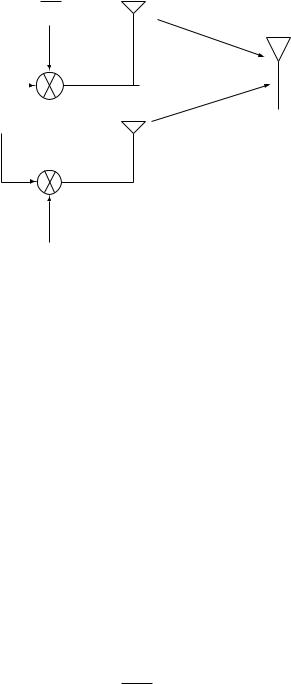
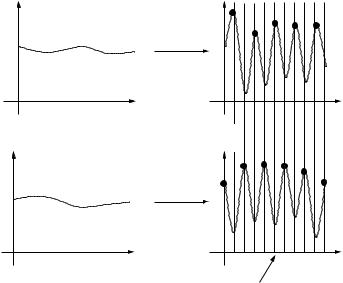
266 |
Multiuser capacity and opportunistic communication |
to ensure that the channel seen by a user does not change abruptly and thus maintains stability of the channel tracking loop.
Slow fading: opportunistic beamforming
To get some insight into the performance of this scheme, consider the case of slow fading where the channel gain vector of each user k remains constant, i.e., hkm = hk, for all m. (In practice, this means for all m over the latency time-scale of interest.) The received SNR for this user would have remained constant if only one antenna were used. If all users in the system experience such slow fading, no multiuser diversity gain can be exploited. Under the proposed scheme, on the other hand, the overall channel gain hkm qm for each user k varies in time and provides opportunity for exploiting multiuser diversity.
Let us focus on a particular user k. Now if qm varies across all directions, the amplitude squared of the channel hkqm 2 seen by user k varies from 0 to hk 2. The peak value occurs when the transmission is aligned along the direction of the channel of user k, i.e., qm = hk/ hk (recall Example 5.2 in Section 5.3). The power and phase values are then in the beamforming configuration:
|
l = |
hlk 2 |
|
l |
= |
1 n |
|
|
hk 2 |
||||||||
|
|
|
t |
|
||||
l = −arghlk |
|
l = 1 nt |
||||||
To be able to beamform to a particular user, the base-station needs to know individual channel amplitude and phase responses from all the antennas, which requires much more information to feedback than just the overall SNR. However, if there are many users in the system, the proportional fair algorithm will schedule transmission to a user only when its overall channel SNR is near its peak. Thus, it is plausible that in a slow fading environment, the technique can approach the performance of coherent beamforming but with only overall SNR feedback (Figure 6.21). In this context, the technique can be interpreted as opportunistic beamforming: by varying the phases and powers allocated to the transmit antennas, a beam is randomly swept and at any time transmission is scheduled to the user currently closest to the beam. With many users, there is likely to be a user very close to the beam at any time. This intuition has been formally justified (see Exercise 6.29).
Fast fading: increasing channel fluctuations
We see that opportunistic beamforming can significantly improve performance in slow fading environments by adding fast time-scale fluctuations on the overall channel quality. The rate of channel fluctuation is artificially sped up. Can opportunistic beamforming help if the underlying channel variations are already fast (fast compared to the latency time-scale)?
